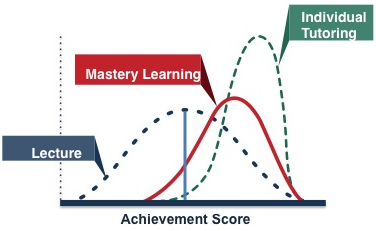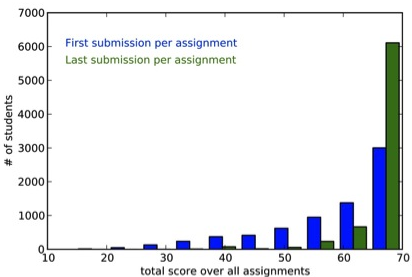Editor’s Note: Want to learn a few tips on how to learn the material in your classes more effectively? Read below to learn about the principles behind Mastery Learning, written by our Course Operations MOOC Pedagogy Specialist, Relly Brandman.
What is Mastery Learning?
In traditional classrooms, students progress through the class regardless of their level of achievement. In mastery learning classrooms, students must fully understand (demonstrate mastery of) the material before moving on to the next topic. Mastery learning is about how students navigate through exercises and assignments.
In a seminal study by Benjamin Bloom1, a mastery learning approach was found to improve the distribution of student scores by a full standard deviation above the control class that used the same method of instruction but didn’t require that students master the material before moving on.

What does mastery learning look like on Coursera classes?
On Coursera, many instructors allow students to have multiple attempts on a single quiz, allowing you to take quizzes several times until you thoroughly understand the material. Instructors have the option to use randomized quiz questions so that students see a different set of questions with each attempt. Mastery learning is characterized by both the opportunity to practice the material, as well as the benchmark for knowing when you’ve mastered the material (e.g. a high score on the quiz).
Martin Odersky (École Polytechnique Fédérale de Lausanne) allowed students to take the quizzes as many times as they wanted in his Functional Programming Principles in Scala course. Many students kept taking the quiz until they received 100%, much like playing a game. This, of course, led to higher scores for that particular quiz. But students who chose to improve their scores by taking the quiz multiple times did better on their first attempts future quizzes as well. For students of similar current performance, mastery-based score improvements correlate with future performance (Figure 2).

I’m a student. How can I use this method to improve my learning?
Keep practicing each class concept until you have mastered it, before moving on to the next concept. If there are multiple attempts allowed for the quizzes and exams in your course, think carefully through each attempt and keep trying until you do really well. Look for as many opportunities as possible to practice, like extra problem sets, background reading, and discussions on the forums. Set clear benchmarks and test yourself on key concepts before moving on to the next. Below are 5 tips to get you started!
Five tips for students to start using Mastery Learning techniques today!
- Chose the topic/module that you want to be a master of (this will likely be found in the course syllabus).
- Write down explicit learning objectives. If these are provided to you by the instructor, re-write them in your own words. If they’re not provided to you by the instructor, consider discussing and honing your learning objectives with your fellow students on the dicussion forums or in your study group.
- Practice, practice, practice! Take and re-take the quizzes available to you, look for extra-practice problems, create practice problems with your study group, etc. Think carefully through each attempt so that you’re getting the most out of your practice.
- Benchmark: figure out if you’ve mastered the material by your performance on the quiz and your ability to address each of the learning objectives. Work with your study group to test each other and give each other feedback.
- Celebrate! Now that you’re a master of the material, you have built a solid foundation for moving on to the next topic.
We hope you enjoyed reading about this topic. Happy learning!
________
1“The 2 Sigma Problem: The Search for Methods of Group Instruction as Effective as One-to-One Tutoring.” B. Bloom, Educational Researcher (1984).
